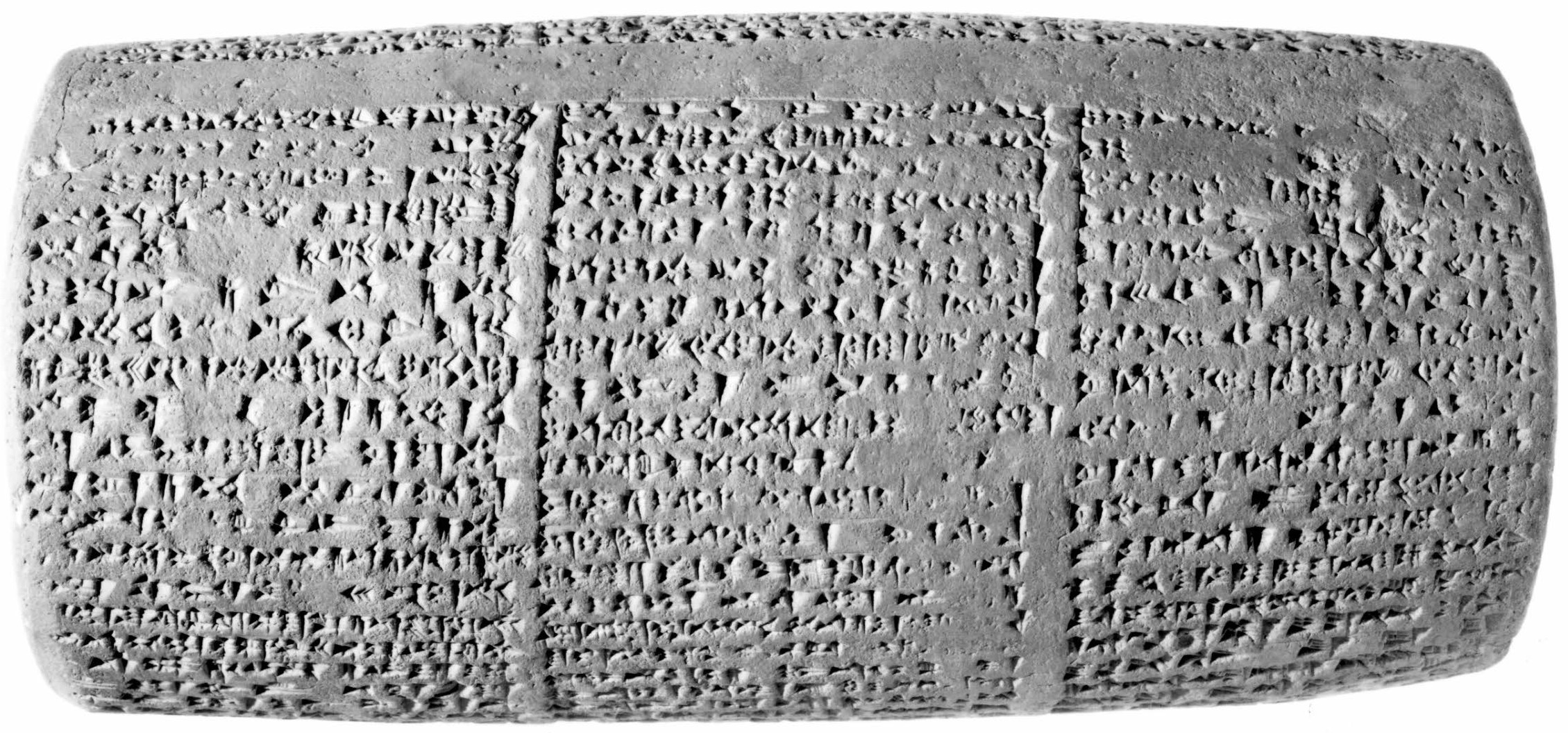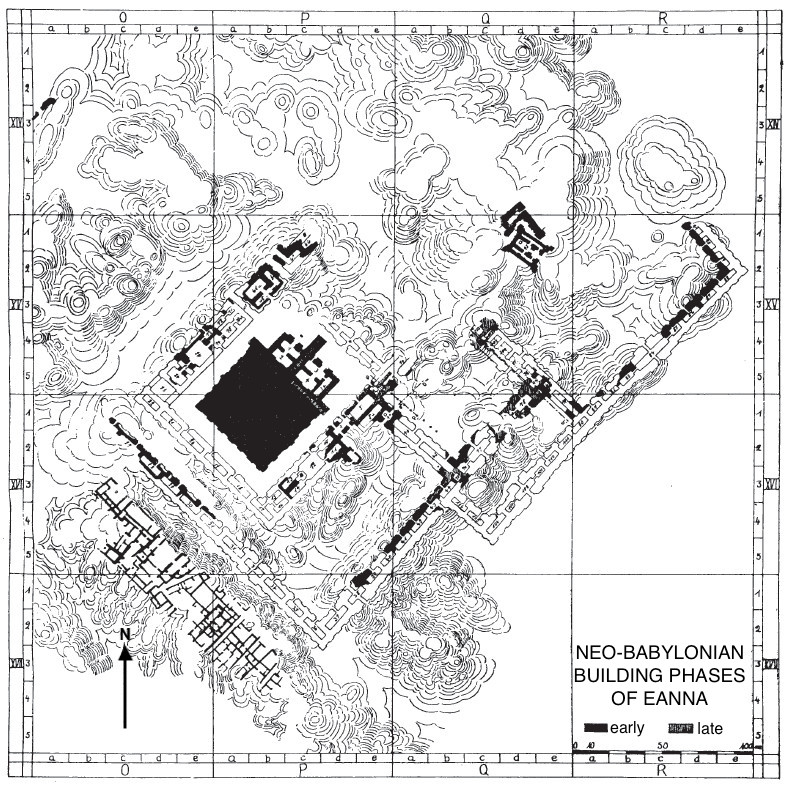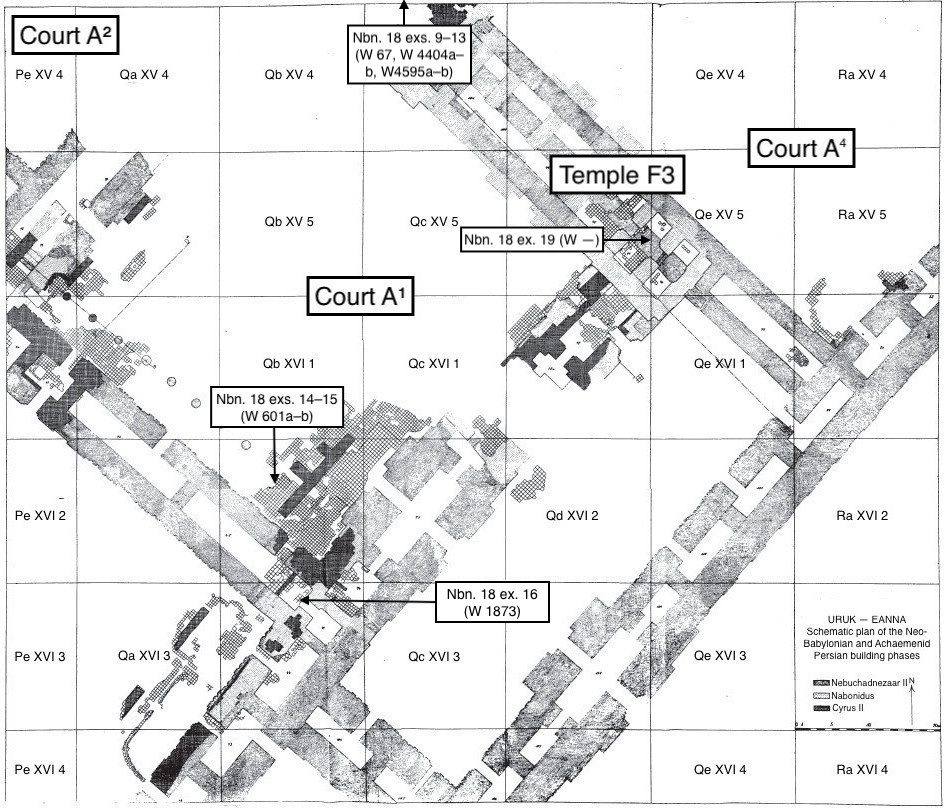Inscriptions of Nabonidus from Kish, Kissik, Larsa, Marad, and Seleucia
Jump to Nabonidus 14 Nabonidus 15 Nabonidus 16 Nabonidus 17 Nabonidus 18 Nabonidus 19 Nabonidus 20
Two clay cylinders discovered at Kish preserve a small portion of an inscription of Nabonidus written in contemporary Neo-Babylonian script; both pieces come from the first column of what are presumed to have originally been two-column cylinders. The extant text contains the end of the section recording the king's epithets and filiation and the beginning of a passage recording Marduk's nomination and support of Nabonidus as the legitimate king of Babylon. H. Schaudig refers to this badly preserved text as the "Kish Cylinder."
Access the composite text [/ribo/babylon7/Q005411/] of Nabonidus 14.
Sources
| (1) Ashm 1969-0582 [/ribo/sources/P451760/] | (2) Ashm 1969-0585 [/ribo/sources/P452314/] ([Kish] 1657) |
Commentary
The master text and lineation is a conflation of exs. 1 and 2. Ex. 1 is the main source for i 1´–8´ and ex. 2 is the principal exemplar used for i 12´–17´. Col. i 9´–11´, however, is a conflation of both exemplars. A score is presented on Oracc and the one minor (orthographic) variant is given in the critical apparatus at the back of the book.
Bibliography
This Akkadian inscription is presently known from a single, damaged double-column clay cylinder discovered at Tell el-Laḥm (probably to be identified with ancient Kissik). The text, which is written in contemporary Neo-Babylonian script, commemorates Nabonidus' rebuilding of the temple of the goddess Ningal at Kissik, Eamaškuga ("House, Pure Sheepfold"); a portion of the building account is completely destroyed. Scholars often suggest that this still-incomplete text was composed during Nabonidus' tenth regnal year (546); for this opinion, see Beaulieu, Nabonidus p. 42 and Schaudig, Inschriften Nabonids p. 48. In previous editions and studies, the inscription is referred to as "Nabonidus Cylinder II, 6," "[Nabonidus] Inscription 10," and the "Eamaškuga Cylinder."
Access the composite text [/ribo/babylon7/Q005412/] of Nabonidus 15.
Source
Commentary
IM 55296 was not available for collation in the Iraq Museum (November 2018) and, therefore, the present edition is based on H.W.F. Saggs' published copy (Sumer 13 [1957] pls. 1–2).
Bibliography
One complete, large, three-column clay cylinder and several fragmentarily preserved cylinders are all inscribed with a lengthy Akkadian inscription of Nabonidus commemorating the restoration of Ebabbar ("Shining House") and Eduranna ("House, Bond of Heaven"), the temple and ziggurat of the sun-god Šamaš at Larsa. Despite the text's Larsa-centric contents, the majority of the copies of this inscription were found at Uruk (exs. 3–6), and not at Larsa (ex. 7) as one would expect. The script of all seven exemplars is contemporary Neo-Babylonian script. The inscription contains: (1) a long introduction enumerating how various gods and goddesses supported Nabonidus; (2) an account of the state of affairs at Larsa prior to Nabonidus' tenth regnal year (546); (3) a passage recording how Nabonidus came to find Ebabbar's original foundations with the help of the god Marduk; (4) a description of how the king confirmed the gods' will through extispicy, not once but twice; (5) a report of the rebuilding of Ebabbar and Eduranna on their original foundations; and (6) concluding formulae, which contain Nabonidus' petitions to Larsa's tutelary deities to look favorably upon him. According to this inscription, Nebuchadnezzar II (wrongly) rebuilt Šamaš' temple on the foundations of a Kassite king by the name of Burna-Buriaš, as he was unable to find Ebabbar's original ground plan; the site of that building was deemed (by Nabonidus) to be too small for its divine occupant. Nabonidus, on the other hand, was able to find Ebabbar's original foundations, which he states had been laid "700 years before Burna-Buriaš" by the famous Old Babylonian king Ḫammu-rāpi; Marduk is said to have sent strong winds that removed the debris covering Larsa's holy buildings and thereby revealed the original ground plans of Šamaš' temple and ziggurat. The inscription, which was composed during Nabonidus' tenth year as king (546) or slightly later, is referred to as "Nabonidus Cylinder III, 1," "[Nabonidus] Inscription 9," and the "Larsa Cylinder" in previous editions and studies.
Access the composite text [/ribo/babylon7/Q005413/] of Nabonidus 16.
Sources
| (1) BM 091143 [/ribo/sources/P518946/] (1885-04-30, 0002) | (2) K 06364 [/ribo/sources/P238635/] |
| (3) NBC 02508 (+) VA 10971 [/ribo/sources/P297259/] (W 03610) | (4) IM 058186 [/ribo/sources/P518947/] (W 18060) |
| (5) IM 058183 [/ribo/sources/P518948/] (W 18025) | (6) IM 059824 [/ribo/sources/P518949/] (W 18418) |
| (7) IM — [/ribo/sources/P518950/] (L 70.17) |
Commentary
The line arrangement follows ex. 1, the only more-or-less complete copy of this inscription. The master text is generally ex. 1, but with help from the other exemplars where that copy of the text is damaged. A score is presented on Oracc and the minor (orthographic) variants are given in the critical apparatus at the back of the book.
As already pointed out by H. Schaudig (Inschriften Nabonids p. 42) and R. Da Riva (GMTR 4 p. 39), the exemplars of the inscription discovered at Uruk (exs. 3–6) were archival copies, that is, they were never intended to be deposited in the structure of the Ebabbar temple at Larsa, unlike ex. 1 (assuming it actually originates from Larsa, and not Uruk). In the Neo-Babylonian Period, Larsa was part of the territory of Uruk; see, for example, Beaulieu, RA 87 (1993) pp. 137–152.

BM 91143 (Nabonidus no. 16 ex. 1), a three-column clay cylinder inscribed with a text commemorating the restoration of Ebabbar and Eduranna, the temple and ziggurat of the sun-god Šamaš at Larsa.
Bibliography
A fragment from the upper part of a round-topped, stone stele discovered in Ebabbar ("Shining House"), the temple the god Šamaš at Larsa, preserves a small portion of an inscription of Nabonidus written in contemporary Babylonian script. The extant text is on the rounded back side of the stele, which was broken in antiquity and reused as a door socket in the Hellenistic Period. On the stele's flat front side, only part of the relief (an image of the king) remains; none of the inscription is preserved on that side of the object, assuming it was also inscribed. The surviving thirty-five lines of text duplicate passages in the well-known "Ḫarrān Stele" (text no. 47). Because the inscription mentions Nabonidus' return to Babylon from his ten-year sojourn in Tēmā, it is certain that the text was composed after this king's thirteenth regnal year (543); H. Schaudig suggests an approximate date of composition between 543 and 540 (Nabonidus' sixteenth year as king). This inscription is referred to as "[Nabonidus] Fragment 1" and the "Larsa Stele" in scholarly literature.
Access the composite text [/ribo/babylon7/Q005414/] of Nabonidus 17.
Source
Commentary
The present edition is based on D. Arnaud's published copy of the stele fragment (Sumer 44 [1985–86] p. 52), since the original in the Iraq Museum was not available for study (because the museum number of the object is not presently known) and since the published photograph is not sufficiently legible. The restorations are based on parallel passages in text no. 47 (Ḫarrān Stele).
Bibliography
Numerous bricks discovered at Larsa and Uruk bear a short, three-line inscription that includes Nabonidus' name, title, and filiation. The text is stamped in archaizing Neo-Babylonian script on the bricks' faces. As proposed by P.-A. Beaulieu (Nabonidus p. 32), theses bricks were likely made between Nabonidus' ninth (547) and eleventh (545) regnal years since Ebabbar ("Shining House"), the temple of the god Šamaš at Larsa, was restored during his tenth year as king (546) and since Eanna ("House of Heaven"), the temple of the goddess Ištar at Uruk, was renovated between Nabonidus' ninth and eleventh regnal years; H. Schaudig (Inschriften Nabonids p. 48) espouses Beaulieu's suggested date. In scholarly literature, this text is referred to as "Nabonidus Brick Ap I, 2" and "[Nabonidus] Inscription 12."
Access the composite text [/ribo/babylon7/Q005415/] of Nabonidus 18.
Sources
| (1) BM 090143 [/ribo/sources/P427787/] (1979-12-20, 0066) | (2) BM 090144 [/ribo/sources/P427788/] (1979-12-20, 0067) |
| (3) BM 090145 [/ribo/sources/P427789/] (1979-12-20, 0068) | (4) BM 090146 [/ribo/sources/P427790/] (1979-12-20, 0069) |
| (5) BM 090147 [/ribo/sources/P427791/] (1979-12-20, 0070) | (6) BM 090159 [/ribo/sources/P427803/] (1979-12-20, 0076) |
| (7) BM 090160 [/ribo/sources/P427804/] (1855-01-01, 0280) | (8) BM 090284 [/ribo/sources/P427905/] (1979-12-20, 0175) |
| (9) W 04404a [/ribo/sources/P518954/] | (10) W 04404b [/ribo/sources/P518955/] |
| (11) W 04595a [/ribo/sources/P518956/] | (12) W 04595b [/ribo/sources/P518957/] |
| (13) W 00067 [/ribo/sources/P518958/] | (14) W 00601a [/ribo/sources/P518959/] |
| (15) W 00601b [/ribo/sources/P518960/] | (16) W 01873 [/ribo/sources/P518961/] |
| (17) W 04233 [/ribo/sources/P518962/] | (18) W 04596 [/ribo/sources/P518965/] |
| (19) W — [/ribo/sources/P518964/] | (20) W — [/ribo/sources/P518963/] |
| (21) IM — [/ribo/sources/P518966/] (L 69.85) | (22) IM — [/ribo/sources/P518967/] (L 70.85) |
Commentary
Because an identical inscription was stamped on bricks incorporated in the superstructures of both the Ebabbar temple at Larsa and the Eanna temple at Uruk, the Larsa and Uruk bricks are edited here as a single text, as they were by H. Schaudig (Inschriften Nabonids pp. 337–338), rather than as two separate inscriptions. Following Schaudig (ibid.), the master text of the inscription is based on ex. 9, even though it is presently only known from A. Schott's hand-drawn facsimile of W 4404a. No score of the inscription is given on Oracc since scores are not provided for texts on bricks.
The square-shaped bricks vary marginally in size. The largest and smallest bricks measure 34.5×33.5×10 cm and 32.5×32.5×8 cm respectively. The stamped area in which the inscriptions are written measure between 21 and 22.7 cm in length and 6.5 and 6.8 cm in height. Three different stamps were used to impress the catalogued bricks; for further details, see Schaudig, Inschriften Nabonids p. 338. On BM 90284, there is a deep imprint of a right foot across the inscription; the text is completely destroyed in that spot.

Plan of the Eanna temple complex in the Neo-Babylonian Period. Adapted from Lenzen, UVB 10 pl. 5.

Annotated plan of the Eanna showing the general find spots of some bricks of Nabonidus discovered in the ruins of Court A@sup{1}, Court A@sup{2}, and Temple F3. Adapted from Lenzen, UVB 10 pl. 2.
Bibliography
Two nearly complete, double-column clay cylinders bear an Akkadian inscription commemorating various building activities of Nabonidus in Babylonia, as well as the installation of his daughter En-nigaldi-Nanna as ēntu-priestess of the moon-god Sîn at Ur. The text, which is written in contemporary Neo-Babylonian script, records that Nabonidus: (1) rebuilt Ebabbar ("Shining House"), the temple of the god Šamaš at Sippar; (2) raised up the superstructures of Ugal-amaru ("Great Storm, (which is) a Deluge") and Melem-kurkurra-dulla ("(Whose) Radiance Spreads over (All) Lands"), the city walls of Cutha and Kish respectively; (3) built the akītu-house of the god Uraš according to its original appearance; (4) undertook construction at the town Ubassu, a cult center of the goddess Nanāya, that was located between Babylon and Borsippa; (5) increased the offerings of Ekišnugal, the temple of the god Sîn at Ur, and installed his daughter as ēntu-priestess there; (6) reconstructed a ceremonial chariot of the god Lugal-Marda; and (7) completely rebuilt Eigikalama ("House, Eye of the Land"), the temple of Lugal-Marda at Marad. Based on the inscription's main building report, both cylinders are thought to have come from Marad, although there is no absolute proof of this. Although the inscription is not dated, its date of composition is generally thought to have been between Nabonidus' third (553) and tenth (546) regnal years, possibly before his sixth year (550) as king; for this opinion, see Beaulieu, Nabonidus pp. 26–27 and Schaudig, Inschriften Nabonids p. 363. In previous editions and studies, this text is referred to as "Nabonidus Cylinder II, 5," "[Nabonidus] Inscription 7," and the "Eigikalama Cylinder."
Access the composite text [/ribo/babylon7/Q005416/] of Nabonidus 19.
Sources
| (1) AO 06444 [/ribo/sources/P518969/] | (2) BM 108981 [/ribo/sources/P345498/] |
Commentary
The line arrangement and master text follow ex. 1. A score is presented on Oracc and the minor (orthographic) variants are given in the critical apparatus at the back of the book.
Both exemplars were purchased and are assumed to have originated from Marad (mod. Wannat es-Sadum) based on their contents. According to the online British Museum Collection database (March 2020), ex. 2 (BM 108981) was purchased in 1914 from J.J. Naaman.
Bibliography
A brick fragment unearthed at Seleucia preserves the final two lines of a short Akkadian inscription of Nabonidus written in archaizing Neo-Babylonian script. The text is inscribed inside a frame that is stamped on the face of the brick. The edition is based on the published photograph of the brick since the present whereabouts of the object are not known.
Access the composite text [/ribo/babylon7/Q005417/] of Nabonidus 20.
Source
Bibliography
Frauke Weiershäuser & Jamie Novotny
Frauke Weiershäuser & Jamie Novotny, 'Inscriptions of Nabonidus from Kish, Kissik, Larsa, Marad, and Seleucia', RIBo, Babylon 7: The Inscriptions of the Neo-Babylonian Dynasty, The RIBo Project, a sub-project of MOCCI, 2025 [/ribo/babylon7/Rulers/Nabonidus/Texts14-20Kish,Kissik,Larsa,Marad,Seleucia/]